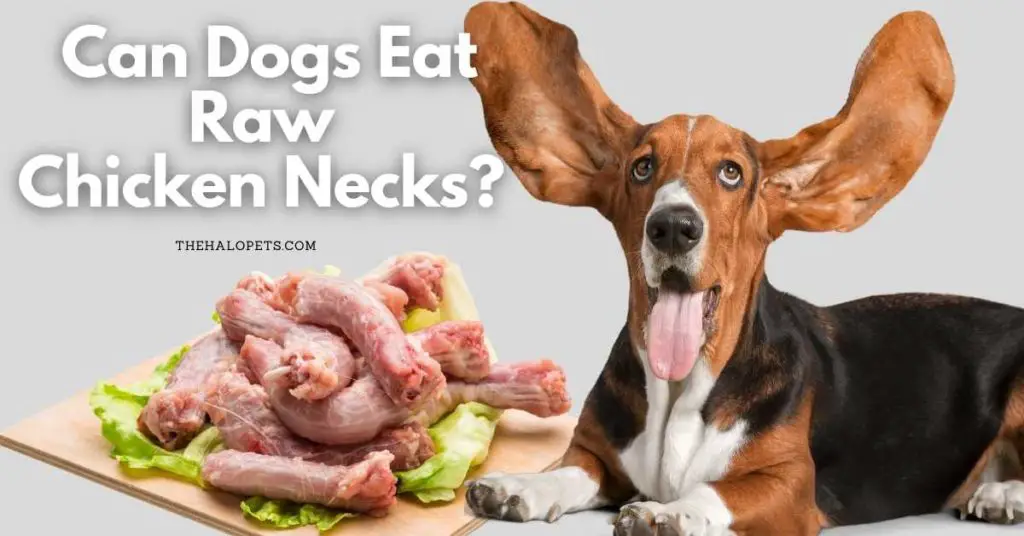If you are inclined towards starting a raw food diet for your dog, raw chicken must have definitely made it to your list.
But, which parts can your dog exactly eat? Can dogs eat raw chicken necks?
In this article, we’ll learn about:
- Can Dogs Eat Raw Chicken Necks?
- 4 Benefits of Raw Chicken Necks
- 4 Risks of Raw Chicken Necks
- And more…
Can Dogs Eat Raw Chicken Necks?

Dogs can eat raw chicken necks when prepared properly to minimize chances of bacteria infection. Don’t serve cooked chicken neck as it becomes brittle, causing choking. Raw chicken necks are high in glucosamine and chondroitin, including them in your pet’s diet will benefit their joint and dental health
Chicken necks are healthy to consume, but why are there still many controversies against feeding raw chicken necks to dogs.
The animosity is not against chicken necks but the entire raw meat-based diet.
Raw meat is generally viewed as food containing harmful pathogens that may cause diseases in dogs. This fact, however, is only partly true. Though raw meat does carry some pathogens, pet owners need not worry about harmful pathogens if they follow proper hygiene.
Aside from disadvantages, there are more positive reasons to feed your dogs raw chicken necks. Raw chicken necks house some of the essential components such as
- Glucosamine and Chondroitin
- Calcium
- Crude Protein
- Magnesium
- Phosphorus
- Potassium
Thanks to the vast collection of some beneficial nutrients, it is safe to say that feeding your dogs chicken necks contributes to your pet’s well-being.
When it comes to serving chicken necks, cooked ones are a no-no (We’ll discuss this in the later section!) . Instead, you can feēd other types of chicken necks, they are:
1. Fresh Chicken Necks
Fresh or raw chicken necks are the ideal raw meat options for your dogs. Start with the small, soft chicken necks if you’re just getting started with a raw meat diet for your dogs. You can fresh chicken necks from your nearby supermarkets and freeze them until you finish feeding them to your dogs.
2. Dehydrated Chicken Necks
Dehydrated Chicken Necks are the mix between cooked and raw chicken necks. These chicken necks are freeze-dried or air-dried using heat or a dehydrator. The dehydrated chicken necks are crunchy to eat, and unlike the cooked ones, the bones don’t break into sharp splinters, so pet parents need not worry about any harm caused by bones.
Here are some dehydrated chicken necks recommendations:
Here are some dehydrated chicken necks recommendations: and No products found. and No products found..
Should I Feed My Dog Raw Or Cooked Chicken Necks?
In the earlier paragraph, we mentioned that cooked chicken necks should be entirely avoided from your dog’s diet. Why?
For many reasons, cooked bones usually lose most of their healthy and vital nutrients in the cooking process. But perhaps the most crucial reason would be that the bones become brittle.
The bones of chicken necks become brittle when cooked. Brittle bones tend to break into sharp, tiny splinters, which can lead to complications such as choking, stomach disease, and even the possibility of the sharp shards cutting the gastrointestinal tract of dogs.
This is why the best option would be feeding raw chicken necks, which are intact with wholesome nutrients dogs and are safe to consume. Of course, it’s important that you follow the hygiene protocols of cleaning the raw chicken neck before serving it to your furry friend.
4 Benefits of Raw Chicken Necks For Dogs

Raw chicken necks contain various vitamins and nutrients, which contribute to their healthy being. Now let’s look into the benefits that come along with feeding your pets raw chicken necks:
1. Improves Oral Hygiene
Chicken necks contain 1.50 % calcium, which implies that eating them will help to keep your gums and enamel healthy. Furthermore, because the necks are made up of tiny bones, when dogs chew on them, the little bones will penetrate the small gaps between the teeth and remove plagues, resulting in healthier and cleaner teeth.
2. Improves Joint Health
Chicken necks are rich sources of glucosamine and chondroitin. According to the VCA Hospital, glucosamine functions as a moderate anti-inflammatory and is utilized by the joints, while chondroitin inhibits cartilage degradation and increases cartilage component formation.
According to Dr. Sarah Wooten, DVM, glucosamine, and chondroitin are some of the joint health supplements recommended by vets.
So if you are not a fan of artificial supplements, you can replace them with raw chicken necks.
3. Provides Important Nutrients
Chicken necks are ample sources of nutrients. Raw chicken sources have a high calcium content, which helps to strengthen bones. They are also high in fat, which is a vital source to enhance the metabolism of dogs.
4. Gives Your Dog A Healthy Coat
According to Dr. Jennifer Coates, DVM, Vitamins A, Zinc, Copper, and sufficient proteins play a part in the health and appearance of dog coats. Raw chicken necks contain a good amount of these vital nutrients.
Also Read: Can Dogs Eat Raw Chicken Bones?
4 Risks Of Raw Chicken Necks For Dogs

Though chicken necks are loaded with some vital nutrients, they also come with a certain number of risks. The following are some of the potential dangers of eating raw chicken necks:
1. Risk Of Choking On Chicken Neck Bones
One of the most common complications associated with dogs eating raw chicken necks is choking. The problem is that when dogs don’t chew properly, they swallow the large neck pieces, which can become lodged in the throat or esophagus and cause choking.
2. Acute Polyradiculoneuritis (APN) in Dogs
Acute Polyradiculoneuritis (APN) is a creeping paralysis due to acute inflammation of the nerves. According to the VCA Hospitals, APN is comparable to Guillain-Barre Syndrome (GBS), in which the body’s immune system attacks a component of the nerve system, causing numbness and weakness in the legs that spreads to the upper body and arms, perhaps leading to paralysis in extreme cases.
According to a study conducted by the University of Melbourne, 96.3% of the APN diagnosed dogs were fed raw chicken, mainly chicken necks and wings.
3. Chicken Allergy
According to the VCA Hospital, most allergens come from proteins. Since raw chicken necks are rich sources of fats and proteins, there are chances of your dog suffering from allergic symptoms from consuming raw necks.
4. Should Be Avoided For Obese Dogs
Raw chicken necks contain 3% fat of daily value. Their high-fat content will contribute a lot to your dog’s energy and are best recommended for underweight and active dogs. However, if your dog is quite bigger than the average size, raw chicken necks should be fed moderately.
4 Tips To Feed Raw Chicken Necks To Your Dogs

Raw chicken is full of nutrients, healthful, and safe. With that in mind, here are some suggestions for feeding chicken necks to dogs:
1. Avoid Seasoning Raw Chicken Necks
In their natural condition, chicken necks are usually appetizing and healthful. So avoid adding any additional seasonings to them, as some seasonings may contain elements that can harm a dog’s health. Onions, garlic, and salt should not be included in your dog’s diet.
2. Follow Safety Precautions
Raw meat contains some harmful pathogens like Salmonella, E coli etc which can cause health issues when consumed by dogs, which is why pet owners should provide their dogs with well cleaned raw chicken necks.
After feeding your pets, make sure to wash your hands well to keep yourself safe from diseases causing pathogens.
3. Feed Them Under Your Supervision
Chicken necks are good for keeping dogs’ teeth in good shape. Dogs must chew the raw necks thoroughly for oral health. Some dogs, on the other hand, may be too lazy to chew and will instead swallow the chicken necks. This may result in issues such as difficulty chewing, gastrointestinal distress, and so on.
This is why pet owners should keep an eye on their pets if they are feeding them raw chicken necks. Make sure they chew thoroughly rather than swallowing.
4. Look For Distress Signals
If you witness your dog acting rather oddly after consuming raw chicken necks. There might be chances that your dog is suffering from food poisoning or any other issues. According to Dr. Katherine Smith, DVM, CVA, CVSMT, some signs of distress exhibited by dogs during food poisoning are:
- Fatigue
- Diarrhea
- Vomiting
- Stretching more often
- Gulping to combat reflux
- Licking their lips, the air, or objects
If your dog exhibits any of the behaviors mentioned above, you should take him to the vet soon.
Also Read: Can A Dog Get Sick From Eating Raw Meat?
At What Age Can Puppies Eat Raw Chicken Neck?

Raw chicken necks are the best raw meat pieces you can start with if you plan to introduce a raw meat diet to your puppies. Puppies of age 3 to 4 weeks can begin eating raw chicken necks.
When feeding raw chicken necks to your puppies, make sure to chop the chicken neck into small and flattened pieces.
How Many Raw Chicken Necks Can I Feed My Dogs?
Chicken necks are high in fat content and contain up to 31 kcal per piece, so they should be moderately fed to your dogs. You can feed your dogs 1 – 2 chicken necks per day.
How Often Can You Feed Raw Chicken Necks To Dogs?
Chicken necks are healthy and high in fat content, so they must be fed moderately in pet diets. You can provide your dogs with raw chicken necks 2-3 times per week.
Can You Give Frozen Chicken Necks To Your Dog?
The majority of microorganisms are eradicated during the freezing process; hence raw chicken necks are recommended to be frozen. Can they, however, be fed to dogs frozen?
Yes! Mostly frozen necks are de thawed before feeding dogs. Feeding them frozen is also acceptable because frozen chicken bones are morse crisp and can pave the way for healthier, less foul-smelling dental hygiene.
Try feeding your dog partially thawed chicken necks to see whether your dog can or cannot consume frozen chicken necks.

